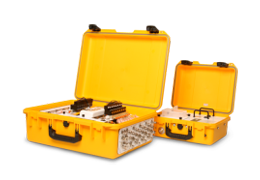The gas analyzer in the LI-8100A is calibrated at the factory using precision gases at controlled temperatures. The calibration function for CO2 uses a rectangular hyperbola and also corrects for temperature and pressure, as well as band broadening and cross-sensitivity to water vapor. The calibration function for water vapor uses a third order polynomial and also corrects for pressure and temperature. The Coefficients pages of the Windows and mobile software display the factory-determined calibration coefficients, and they are also recorded on a calibration sheet that comes with the instrument.
Like all infrared gas analyzers, the LI-8100A optical bench zero and span may drift over time with changes in temperature, cleanliness of the optical bench, and other factors. The zero and span procedure discussed in this section is used to correct for any drift that may occur. Setting zero and span makes the instrument measurements conform to expected values.
Zero and span should be checked periodically, the frequency depending upon accuracy requirements and the variability of the environment in which the LI-8100A is used. The majority of the analyzer drift is corrected by setting the zero, so this should be the highest priority. It is also a good idea to verify analyzer performance by periodically checking the span. If you begin checking these on a daily basis and keep a log of zero and span adjustments, you will learn how much your analyzer drifts and how frequently you need to zero and span.
The calibration of the instrument shifts if the optical path gets dirty. Most of this shift is corrected by setting the zero and span, but the calibration curve linearity may also change if the optical path becomes extremely dirty. Linearity can be tested using two span gases and a zero gas. Set the zero and span as usual, and then measure a known intermediate gas concentration. The concentration measured should be within the instrument specification, taking into account the known accuracy of the intermediate gas. If that is not the case, clean the optical path as described in Cleaning the optical bench. Linearity changes are small even when the cell becomes quite dirty, so frequent cleaning of the optical path should not be necessary, especially if the filters are kept clean.
